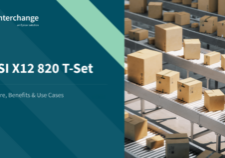Exploring Cloud EDI Services in ERP: Architecture, Security, and Scalability
ERP and EDI integration is critical for modern business operations. EDI facilitates the exchange of information between your business, supply chain partners and customers. ERP organises that information to guide and communicate internal business operations. Mistakes, delays and manual processes can disrupt this information flow, damaging planning, performance and delivery.
Traditional EDI/ERP integrations place complex technical roadblocks in your way. Many businesses have turned to the cloud for answers, which has been made easier by the adoption of open-source technologies. However, the cloud presents challenges of its own, namely:
- Data security and compliance: Although cloud service providers employ stringent security measures, no system is immune to breaches. Depending on the industry, data storage, and handling requirements may be subject to specific regulations (like GDPR and HIPAA) that the cloud solution needs to comply with.
- Interoperability: It can be difficult to integrate a cloud-based system with other existing in-house or cloud-based systems, especially if they are from different vendors.
- Hidden Costs: While cloud solutions can be more cost-effective, there are also hidden costs. These could include costs related to data migration, network bandwidth needs, or premium services.
This article will dive into how to side-step these pitfalls while embracing the strategic shift in enterprise planning and supply chain management delivered by effectively uniting your EDI and ERP systems in the cloud. Let’s get started.
Understanding EDI services in ERP: The architecture
The architecture of integrating EDI with your ERP involves a complex network of data exchange, storage, and real-time updates. Critically, you need to consider:
- Data processing: EDI is responsible for transforming business documents into a standardised format. This uniformity allows for the effective processing and integration of data by ERP systems.
- Data storage: Processed data is subsequently stored within ERP platforms. Often cloud-based, these environments facilitate easy access, retrieval, and analysis of the data.
- Real-time updates: To prevent data sets from getting out of date, you have to ensure that changes made at one end are reflected almost instantly across all linked functions, ensuring a consistent data landscape.
What good looks like
A high-functioning integrated EDI and ERP system is more than the sum of its parts. It enhances the effectiveness of operations while providing additional benefits:
- Seamless integration: Above all, such a system ensures an uninterrupted, efficient link between ERP and EDI. This includes taking into account compatibility with various data formats, transfer protocols, and security measures.
- Minimal manual operation: Leveraging cloud-based capabilities, these systems reduce the need for manual intervention, thereby increasing efficiency and reducing the potential for errors.
- Interoperable: You need to make sure that your cloud-based systems can be integrated with existing technology, particularly legacy on-prem systems. An EDI partner can help assess your existing tech stack and build any bespoke integrations required.
Data Security: Protecting your supply chain
Data security is paramount for any cloud migration. Financial and reputational damage loom large. However, if done right, removing manual steps can actually improve security, helping prevent a data breach and ensure regulatory compliance.
So how do you protect your data? Here are some best practices:
- Encryption: Encrypting data in transit and at rest adds a layer of protection.
- User access controls: Limiting who can access what data can not only prevent internal leaks but also reduce the surface area for potential attacks.
- Regular audits: Auditing your security measures can help identify any potential weaknesses and address them proactively.
What good looks like
Data security should go beyond reacting to threats and pre-empting potential security issues. That means:
- Proactive measures: High-functioning systems constantly monitor for unusual activity, allowing them to detect and respond to potential threats in real time.
- Advanced security protocols: This includes using leading-edge encryption methods and continually updating these in line with advancements in technology.
- Regulatory compliance: Top-tier solutions will not just meet but exceed regulatory requirements, offering peace of mind that your data is adequately protected.
Of course, all of these requirements are specific to the nature and risk profile of your business. You need partners who take security seriously and can match your needs.
Scalability and cost implications: Adapting to changing business needs
In general, scalability is an important motivating factor for cloud adoption. The cloud makes it possible to expand or contract access to infrastructure and software at the touch of a button. Cloud-based EDI and ERP systems are no different. What’s more, an integrated and sophisticated EDI and ERP system provides additional capabilities critical to scaling business operations, specifically:
- Supply chain flexibility: As your business grows, you may need to adopt new supply chain partners. A cloud-based EDI system can handle varied types of EDI formats, enabling easy integration with new suppliers and partners.
- Operational flexibility: Cloud-based ERP systems provide a flexible base on which to scale up or down data storage, access and features to match supply chain changes, eliminating the need for time-consuming and expensive infrastructure overhauls.
Critically, pay-as-you-go models offered by many cloud-based services allow you to directly correlate costs with usage, ensuring that you don’t overspend on services you don’t need.
What good looks like
So what does a scalable and cost-effective solution look like?
- Adaptive infrastructure: This means robust, flexible infrastructure that adapts as your business grows or contracts. The ease of modifying services to match your current needs is a key attribute of a good solution.
- Usage-based costing: The best solutions offer usage-based costing models, ensuring you’re only charged for the capacity you use. This keeps your budget in check while maximising operational efficiency.
- Transparent pricing: Beyond usage-based costing, all suppliers should be able to provide a full cost breakdown, including the costs of any additional, premium services. Specifically, look at any costs associated with data migration and price differences between uploading and downloading data into the cloud.
- Easy expansion: It’s critical that you can grow your systems to match business expansion without requiring major overhauls or migrations. Quality providers will be able to demonstrate when and where this is possible.
Recognising the cost benefits of scalable, integrated EDI and ERP systems will allow you to make an informed decision about such an investment.

The value of an EDI partner
An EDI partner can help you navigate the complexities of EDI and ERP integration, and vastly simplify your general application of EDI. The future of EDI depends on its direct integration with a full range of critical business applications. Getting your EDI and ERP integration right is the linchpin of success.
At Data Interchange, we’ve baked ERP solutions into the heart of our EDI services. We can create bespoke integrations for any ERP provider and have off-the-shelf functionality for SAP, Sage, Dynamics, Oracle, Netsuite and Infor. No matter what ERP you’re using, this provides you:
- Single connection, multiple partners: Our DiNet Value Added Network enables you to manage a single connection, yet communicate with over 10,000 business partners. This feature significantly simplifies your network management.
- Transparency and control: With built-in audit trail functionality and sophisticated analytics and reporting capabilities, you gain full visibility over your data exchanges.
- Reliability: Our services exceed 99.95% availability, ensuring uninterrupted transmission of your EDI messages.
- Security: You can rest assured about the safety of your sensitive information, with our commitment to data encryption and ISO 27001 certification.
- Future-ready technology: Our advanced tools offer dashboards equipped with filtering, alerting, and reporting capabilities, positioning your business to embrace evolving technologies and trends.
We have the experience to guide you on your journey of EDI and ERP integration. If you’re ready to move into the cloud with confidence, get in touch.



























































































































